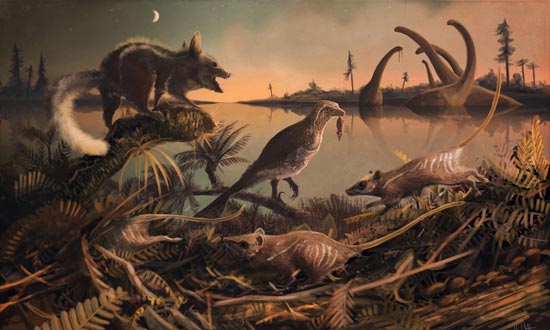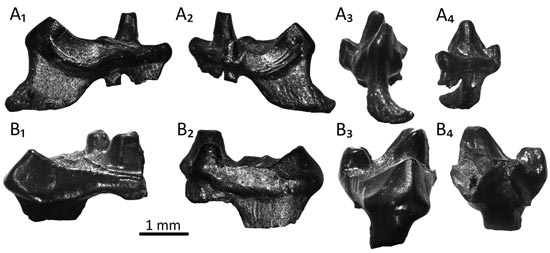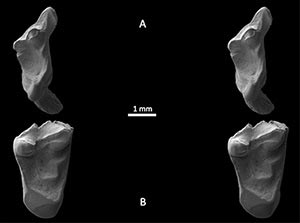Durlstotherium newmani and Durlstodon ensomi
Finally got round to reading the paper on the discovery of evidence of Eutherian (placental) mammals in Early Cretaceous deposits on, ironically, “the Jurassic Coast”. The two teeth found during sieving of material collected on the Dorset coast by University of Portsmouth undergraduate student Grant Smith, has led to the erection of two new mammal species.
These fossils represent the earliest, undisputed fossils of mammals that belong to that same group of mammals – the placentals, as we do. It is wonderful to think that the Dorset coast can still provide amazing fossil discoveries and secondly, it is great that such an important discovery can be made by a relative newcomer to the science of palaeontology. Well done to all involved in the research and the writing of the academic paper, published in the journal “Acta Palaeontologica Polonica”.
It also gives us an excuse to include the amazing image created by Dr Mark Witton that illustrates the Purbeck palaeoenvironment around the beginning of the Cretaceous.
Dorset Around 145 Million Years Ago

Picture credit: Mark Witton
The two teeth, found at Durlston Bay near Swanage, represent two rat-like Eutherian mammals. These creatures have been named Durlstotherium newmani and Durlstodon ensomi. In Dr Witton’s remarkable illustration (above), a scene at dusk is depicted. It is most likely that these early placentals were nocturnal, even so, as darkness fell there were still plenty of dangers lurking.
The sauropods in the background might not pose much of a threat to our distant ancestors but in the centre of the image, a Durlstotherium has been caught by a two-metre-long theropod dinosaur Nuthetes destructor. This dinosaur is mainly known from isolated teeth and based on such fragmentary evidence it is difficult to place Nuthetes within the dinosaur family tree, however, it has been suggested that it was a dromaeosaurid. Thus, the Purbeck area of southern England during the Early Cretaceous was not only home to placental mammals but, potentially, also the residence of the earliest known member of the Dromaeosauridae.
Evidence of Placental Mammals
One of the authors of the paper on the two new mammals, Dr Steve Sweetman (Research Fellow at the University of Portsmouth), concluded that the fossilised teeth and jaw fragment ascribed to N. destructor indicate a taxonomic affinity with the Velociraptor branch of the Dromaeosauridae family.
Various Views of the Two Fossil Teeth (Durlstotherium and Durlstodon)

Picture credit: Portsmouth University
Dr Sweetman, an expert in the dentition of small vertebrates explained how Grant Smith discovered the fossil teeth:
“Grant was sifting through small samples of earliest Cretaceous rocks collected on the coast of Dorset as part of his undergraduate dissertation project in the hope of finding some interesting remains. Quite unexpectedly he found not one but two quite remarkable teeth of a type never before seen from rocks of this age. I was asked to look at them and give an opinion and even at first glance my jaw dropped!”
With Mammal Fossils It’s All About the Teeth
While these Dorset fossils may seem a little underwhelming, comprising only two molar teeth with no roots, that measure just a few millimetres across, the unique specialisations of mammal teeth for processing food result in complex tooth shapes. These shapes evolve in patterns that allow palaeontologists to identify what group a mammal belongs to, meaning that even a single tooth can permit palaeontologists to gather a great deal of information.
The wonderful thing about mammal teeth is that they are very distinctive. Every type of mammal has a different set of teeth. The teeth vary in shape from the back to the front of the jaw and you can tell from a single tooth fossil exactly where in the jaw it was located, whether it came from the upper or lower jaw, whether it was on the right side of the skull of the left side. The pattern on the crowns of the teeth (molars and premolars) provides information on the type of diet the animal had.
These fossil teeth from the Early Cretaceous of Dorset, might be extremely small, but they can tell us a great deal about the animals which had the teeth and provide information on the evolutionary relationship between these animals and other members of the Mammalia.
Dr Sweetman added:
“The teeth are of a type so highly evolved that I realised straight away I was looking at remains of Early Cretaceous mammals that more closely resembled those that lived during the latest Cretaceous, some 60 million years later in geological history. In the world of palaeontology, there has been a lot of debate around a specimen found in China*, which is approximately 160 million years old. This was originally said to be of the same type as ours but recent studies have ruled this out. That being the case, our 145 million year old teeth are undoubtedly the earliest yet known from the line of mammals that lead to our own species.”
* The fossil from China that Dr Sweetman is referring to Juramaia sinensis a tiny, shrew-like mammal, fossils of which come from 160 million-year-old deposits from the Tiaojishan Formation of Liaoning Province. Juramaia was named in 2011, it has been controversially described as a basal Eutherian mammal and it suggests that the very earliest placentals were probably arboreal.
To read Everything Dinosaur’s article about this fossil discovery: The “Mother” of all Placental Mammals.
If Juramaia is proved to be an Eutherian, then this indicates that placental mammals had their origins in Asia in the Jurassic and that they had spread across Asia to Europe (Laurasia) by the Early Cretaceous.
Scanning Electron Microscope Images of the Tiny Purbeck Teeth

Picture credit: Portsmouth University
Very Worn Molars
The crowns of the teeth are very worn, this suggests that despite the threat of being eaten by predatory dinosaurs, both mammals lived a long time.
Professor David Martill, who supervised the research project and is a co-author of the scientific paper stated:
“What I’m most pleased about is that a student [David Grant] who is a complete beginner, was able to make a remarkable scientific discovery in palaeontology and see his discovery and his name published in a scientific paper. The Jurassic Coast is always unveiling fresh secrets and I’d like to think that similar discoveries will continue to be made right on our doorstep.”
One of the new species has been named Durlstotherium newmani, honouring Charlie Newman, a keen, amateur fossil hunter and the landlord of the Square and Compass pub in the village of Worth Matravers, near to where the fossils were discovered. The trivial name of the second species, Durlstodon ensomi honours Paul Ensom, a palaeontologist who did much to improve our understanding of the palaeoenvironments represented by the geology of Dorset.
For dinosaur and prehistoric animal models: Prehistoric Animal Models.






Thanks for your kindly share, so the animals’ teeth would not be broken?